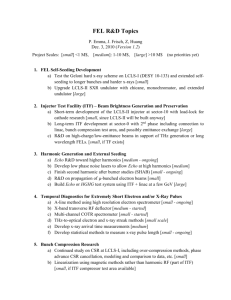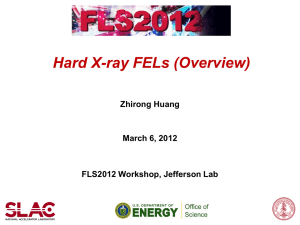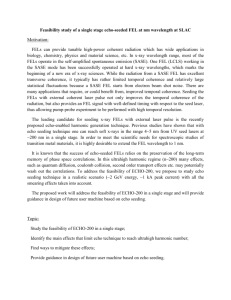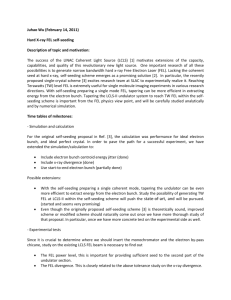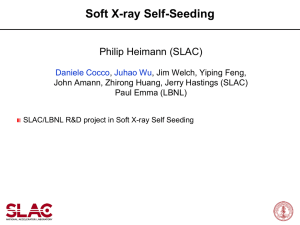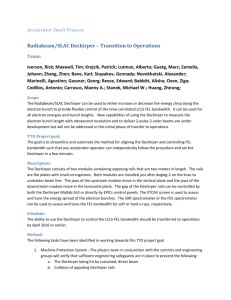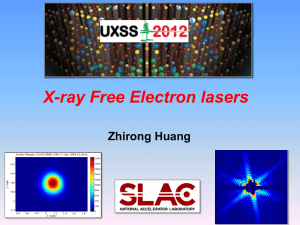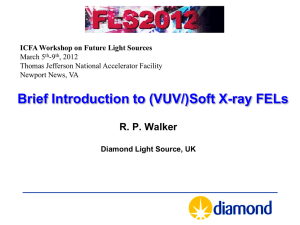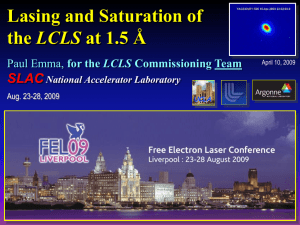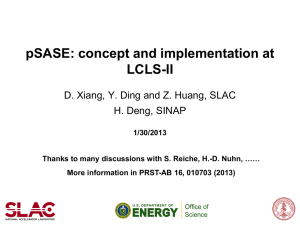LCLS: Realization of the Dream
advertisement
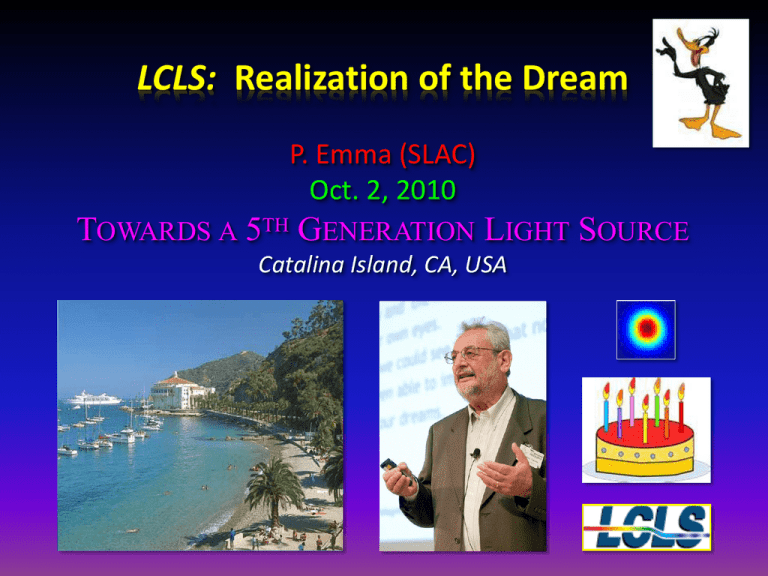
LCLS: Realization of the Dream P. Emma (SLAC) Oct. 2, 2010 TOWARDS A 5TH GENERATION LIGHT SOURCE Catalina Island, CA, USA First Hard X-Ray Free-Electron Laser is Successful gex,y = 0.4 mm (slice) Ipk = 3.0 kA sE/E = 0.01% (slice) (25 of 33 undulators installed) LG = 3.3 m IT WORKS! The LCLS Proposal… 1992 C. Pellegrini, “A 4 to 0.1 nm FEL based on the SLAC linac”, in Workshop on 4th Generation Light Sources, M. Cornacchia and H. Winick, (Eds), pp. 364-375, 1992. SSRL-Report-92/02. “…one is forced to have high gain, i.e. to use electron beams with large peak current, and at the same time small emittance and energy spread. The road to an X-ray FEL requires the development of electron beams with unprecedented characteristics.” Will show only one simple equation… -+ ? = Claudio’s & UCLA’s Efforts Produce 3 FELs in 5 years M. Hogan et al., Phys. Rev. Lett., 80, 289–292 (1998). M. Hogan et al., PRL, 81, 4867–4870 (1998). SASE Process Just FEL Taking 16Offmm UCLA 16-mm LANL/UCLA AFEL 12 mm IR Detector Signal [mV] 70 60 50 Spontaneous @ 16µm, w ithin žc 16µm w ithin žc Ginger - normalized to 0.2nC data Fit 40 30 >105 gain 20 10 0 0.2 0.3 0.4 0.5 0.6 Charge [nC] (LEUTL at ANL Saturates in Sep. 2000) VISA A. Tremaine et al., PRL. 88, 204801 (2002) 840 nm March 2001 saturation starts BNL-LLNL-SLAC-UCLA VISA at BNL 16 March 2001 Thanks to Herman Winick, Max Cornacchia, and John Galayda H. Winick First Design Study (1992 – 1995) Report describes final LCLS quite accurately Journal of Electron Spectroscopy and Related Phenomena, Vol. 75 (1995), pp. 1-8. M. Cornacchia Design Study Report (1996 – 1999) First funding and collaborations established SLAC-R-521, Dec. 1998 J. Galayda Construction Phase (2001 – present) Scope expands to user facility, construction, commissioning, + user op’s. First light: April 9, 2009 What’s so Special About “1 nC” Anyway? C. Pellegrini, X. Ding, J. Rosenzweig, “Output Power Control in an X-Ray FEL”, PAC-99, New York, NY, March 1999. 1 - 0.1 nC We had never even considered <1 nC before this (PE). P. Emma, “LCLS Accelerator Parameters and Tolerances for Low Charge Operations”, SLAC-TN-05-042, May, 1999. 0.1 nC P. Emma et al., “An Optimized Low-charge Configuration of the Linac Coherent Light Source”, PAC-05, Knoxville, TN, May 2005. 0.2 nC (resistive wakes under control) LCLS runs mostly at 0.25 nC, much due to Claudio’s 1999 suggestion J. Rosenzweig, …, C. Pellegrini, … et al., “Generation of ultra-short, high brightness electron beams for single-spike SASE FEL operation”, Nucl. Instrum. Methods Phys. Res., Sect. A 593, 39 (2008). 0.001 nC Y. Ding et al., “Measurements and simulations of ultralow emittance and ultrashort electron beams in the linac coherent light source”, Phys. Rev. Lett. 102, 254801 (2009). 0.02 nC LCLS Low Charge Operation Now Routine (20 pC) 15 Å, z = 25 m, 2.41011 ph’s, Ipk = 2.6 kA, ge 0.4 µm Y. Ding 1.2 fs 0.14 µm z = 25 m 20 pC, 135 MeV, 0.6-mm spot diameter, 400 µm rms bunch length (5 A) Sliced OTR screen with transverse deflector ON Idea to run with 20 pC was first suggested by Joe Frisch, but it was hastened by discussions with Claudio at SLAC in 2008. How do we get to <10 femtosecond pulses? Max and Claudio form a “brain-storming” series of meetings in 2002 with a goal of <10 fs… Many ideas emerge – some fall by the wayside, and 1-2 look good Transverse RF cavities in the undulator More electron compression Chirped FEL + X-ray compression1 Chirped FEL + monochromator2 Slotted foil… 1. C. Pellegrini, “High Power Femtosecond Pulses from an X-ray SASE-FEL”, NIM A 445 (2000), 124-127. 2. C. B. Schroeder, C. Pellegrini, et al., “Chirped-beam Two-stage Sase-FEL For High Power Femtosecond Xray Pulse Generation”, PAC-01, Chicago, IL, 2001. Pulse Length Easily Adjusted (500-60 fs)* X-Ray Pulse Energy vs. Pulse Length (2.5 – 3.8 mJ) Peak FEL Power vs. Pulse Length (5-40 GW) 1.7 keV, 250 pC, 23 of 33 undulators inserted e- bunch length is quickly adjustable (<1 min) from 60 to 500 fs (hard x-rays: 60 to 100 fs) * for soft x-rays (0.5-2 keV) Energy DEFW/E ≈ 1.0% Dt ≈ time 200 fsec x-ray pulse Self-seeding may soon be added to LCLS (Geloni et al) allowing Claudio’s scheme to be tested Energy Two-stage Undulator for Shorter Pulses 10-4 Dt ≈ time 40 fsec Si monochromator (T = 40%) time Mitigates e- energy jitter and undulator wakes time UCLA e43 m 30 m SASE gain (Psat/103) C. Schroeder, et al. 52 m SASE Saturation (25 GW) Also a DESY scheme which emphasizes line-width reduction (B. Faatz) Slotted Foil To Produce Narrow or Double X-Ray Pulses Idea grew out of meetings with Max and Claudio in 2002-2003: Thanks to Clive Field, Mark Petree, et al. PRL 92, 074801 (2004). FEL power is proportional to slot width (short pulses?) FEL X-ray Pulse Energy (mJ) Scan only the single-slot section OTR screen in BC2 (1 ft up-beam of foil) How is an FEL Like a Refrigerator? Great work was certainly done at SLAC to build this machine, …and we are all, understandably, quite proud of this effort. However, as I get more time to appreciate the novelty, complexity, and history of this amazing machine, I also come to appreciate another side… The performance of this machine was theoretically predicted so accurately that the damn thing worked like a brand new refrigerator just out of the box? Yes, we did a good job, but don’t forget that we were provided with a clear and realistic recipe from Claudio and many others who led the way. I stand in amazement at the FEL theorists who brought us this far, and did it mostly with pencil and paper! A Crazy Idea? From Herman Winick: “…the great majority of scientists thought that it was a crazy idea and that it would never work.” So let’s look at just a few of the accelerator and FEL physics challenges that stood in the way to see how crazy it really was… CSR Can Ruin Bend-Plane Emittance in Bunch Compressors! Use new skew-quad diagnostic to see timeresolved CSR effects… Actual Measurements 250 pC skew quad OTR12 skew quad streaks beam on OTR12 Energy loss BPM X Reading after BC1 (mm) -25.0° -22.0° -28.0° -27.0° -25.5° -26.0° -23.0° -24.0° -26.5° bunch length Skew quad in BC1 streaks beam vertically on OTR screen Energy-loss induced steering after BC1 Electron beam needs heating or it will m-bunch in the linac! Heater OFF bunch length m-bunching on dump screen in overcompression Heater ON Must have a 5-mm straight trajectory over a gain length! Get additional e-/photon slippage (phase error) with imperfect trajectory 1Å e- and photons phase matched e- vs. photon phase error <5 mm 5m Trajectory straightness requirements are frighteningly tight ! Producing a sufficiently straight undulator trajectory requires an empirical beam-based alignment method Must Preserve 1-Å Micro-Bunching Over Long Undulator! Now let’s draw this more accurately, choosing a 1-mm period… 2 km! 1 Å (0.0001 mm) Aspect ratio? 30 mm And we must preserve this over a 130-m long 1 mm undulator! FEL m-bunching ? e- In Closing… So was it a crazy idea … ? Yes, I must agree… …completely bonkers! But thanks Claudio, for such a wonderfully crazy idea !
